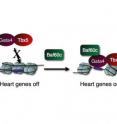Gladstone scientists identify key factors in heart cell creation
Scientists at the Gladstone Institute of Cardiovascular Disease have identified for the first time key genetic factors that drive the process of generating new heart cells. The discovery, reported in the current issue of the journal Nature, provides important new directions on how stem cells may be used to repair damaged hearts. For decades, scientists were unable to identify a single factor that could turn nonmuscle cells into beating heart cells. Using a clever approach, the research team led by Benoit Bruneau, Ph.D., found that a combination of three genes could do the trick. This is the first time any combination of factors has been found to activate cardiac differentiation in mammalian cells or tissues.
"The heart has very little regenerative capacity after it has been damaged," said Dr. Bruneau. "With heart disease the leading cause of death in the Western world, this is a significant first step in understanding how we might create new cells to repair a damaged heart."
Two of the three genes encode proteins called transcription factors, which are master regulators that bind to DNA and determine which genes get activated or shut off. The two transcription factors, GATA4 and TBX5, cause human heart disease when mutated and also cooperate with each other to control other genes. When Dr. Bruneau and postdoctoral fellow Jun K. Takeuchi added different combinations of transcription factors to mouse cells, these two seemed important for pushing cells into heart cells—but they were not enough.
"When we finally identified the key factor that could work with GATA4 and TBX5 to turn cells into beating heart cells, it was somewhat of a surprise to us," said Dr. Bruneau.
The surprising factor was a cardiac-specific protein called BAF60c, which helps determine whether transcription factors like GATA4 and TBX5 can even gain access to the DNA regions they were supposed to turn on or off. "Our previous studies had shown that chromatin remodeling complexes were important," said Dr. Bruneau. "Mice with lower levels of these complexes have severe heart defects and defective cardiac differentiation. These observations prompted us to look at Baf60c in heart differentiation."
The effect was dramatic. Addition of the three factors directed differentiation of mouse mesoderm, which normally has the potential to make bone, blood, muscle, heart, and other tissues, specifically into cardiac muscle cells (cardiomyocytes) that beat rhythmically, just like normal heart cells. In fact, even cells that normally contribute to the placenta could be induced to transform into beating cardiomyocytes.
"Together, these factors give us a potent mechanism to control cellular differentiation," said Dr. Bruneau. "This knowledge may help us to understand how to reprogram new cardiomyocytes for therapeutic purposes."
Source: Gladstone Institutes
Other sources
- Scientists identify key factors in heart cell creationfrom Physorg16 years ago


